A week in the life of P‑22, the big cat who shares Griffith Park with millions of people
Mountain lion shows the promise, peril of coexistance
Source of this article: The Los Angeles Times, February 8, 2017
The lion slinks through the chaparral, a blur of movement in the night. Head held lower than his shoulders, he scours the brush in a ravine just south of Travel Town in Griffith Park.
Hind paws land where the forepaws lift. No twig snaps, no crinkling leaf. He’s silent, an ambush predator, always hunting, always looking for opportunity.
Inside a small gray box on his neck, a microprocessor switches on to calculate and time stamp his location — 21:00, Dec. 2, 2016 — one of 56 readings made in the course of a week. The coordinates reveal the lion’s rambling course through this island of wilderness in the midst of the city.
As famous as he is, the mountain lion known as P-22 is a mystery, his day-to-day life hidden by his instincts for evasion.
The National Wildlife Federation has called the species a “nearly perfect predator,” and among the survival skills, fine-tuned over 40 million years of evolution, is a talent for invisibility.
What evolution did not prepare P-22 for is how to exist in an eight-square-mile urban park with more than 5 million human visitors a year. Most male cats have almost 20 times that space, nearly to themselves.
On this night, his ears twitch to a distant rustling, another creature’s lapse of caution. It comes from a steep gully, overgrown by willows.
P-22 turns his head in advance of the quick and deadly attack to come.
A few days before, in November, another lion had the same intention when he broke into the unsecured pens of two ranches in the Santa Monica Mountains, killing nearly a dozen alpacas and a goat.
The state wasted no time issuing a permit to kill P-45, and advocates rushed to champion the rights of the condemned cat. At a public meeting a few days later, the crowd grew contentious.
When a man asked whether P-45 might be deviant or rogue for having killed so many animals in one night, the crowd booed and jeered.
When a woman proclaimed, “We are here because these animals cannot speak for themselves,” most in the group applauded.
An online petition — “Stop the permit to kill!” — drew more than 1,000 signatures from supporters as far away as Moscow and Cape Town. The big cat was granted a reprieve.
The decision reflected the opinion of the biologist who matter-of-factly explained: “P-45 is a lion being a lion.”
The mountain lion’s offense would have met with less sympathy back when the cats ranged throughout Rancho Los Feliz and Elysian Park. It would have been seen as an opportunity for sport.
“There may be an element of excitement in stalking royal Bengal tigers in their native jungles, or pursuing the ivory tusked elephant in the sacred preserves of the Ahkood of Swat, but for exhilarating sport, lightly spiced with danger and possessing some other merits of consideration, hunting mountain lions within the city limits of Los Angeles stands preeminent.”
The Times’ account of the 1892 hunt continued with descriptions of the deep-voiced bay of the hounds, the cries and tootings from the tally-ho horn, the gunshots.
Mercy, let alone adulation, was not likely back then.
From the moment P-22 was discovered, he was a celebrity. His image soon adorned the cover of National Geographic. Writers opened at least six Twitter accounts in his name, feeding him lines with late-night flair: “I like free range organic kale-fed deer.” “Building a wall along our border with Burbank to keep out golden retrievers.”
The city honored him with a day of recognition (Oct. 22), and filmmakers are about to debut a documentary about his life with the grandiose title, “The Cat That Changed America.”
His residency, however, has not been without mishap.
He has ingested rat poison from eating smaller prey and contracted a bad case of mange.
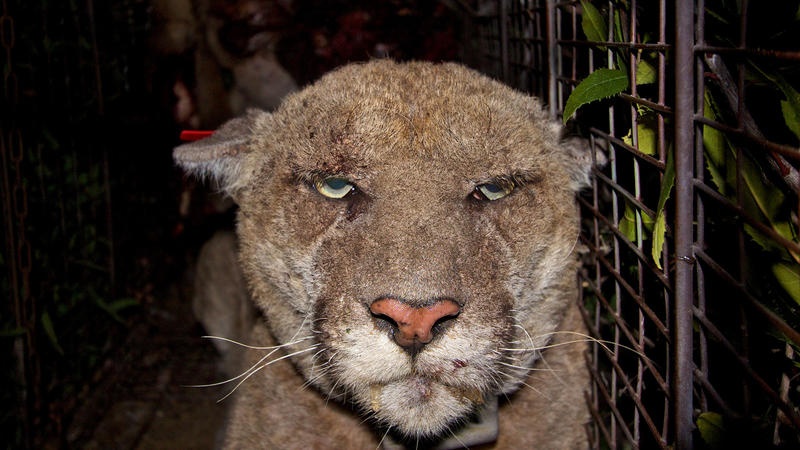
Scientists recaptured P-22 in late March and, after noticing crusting on his fur and skin, treated him for mange.
He wandered into the crawl space of a home in Los Feliz and endured a day-long assault by authorities who peppered him with bean bags and tennis balls.
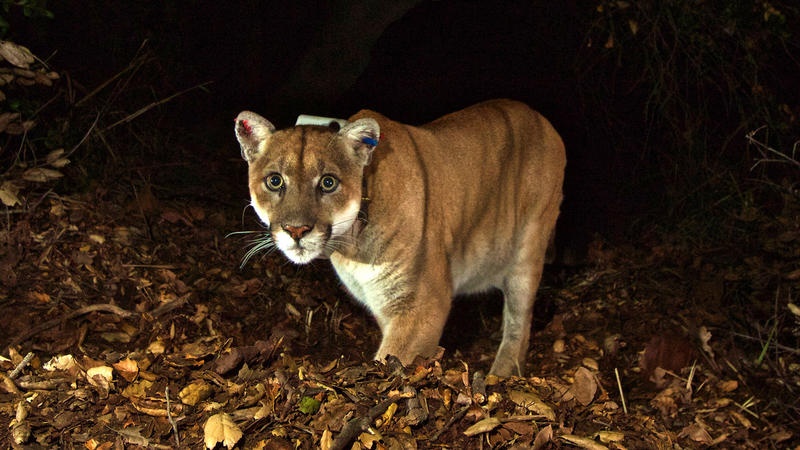
Months after turning up looking sickly and suffering from mange, Griffith Park’s resident mountain lion and unofficial mascot, P-22, is looking much healthier.
Then there was the incident a year ago with Killarney, the 14-year-old koala, who went missing from her enclosure at the Los Angeles Zoo. GPS data and a surveillance video put P-22 at the scene, and most assume the koala became a meal.
Like the best L.A. stories, his debut was captured on a camera. A team of researchers had been studying the movement of wildlife in and out of Griffith Park, seeing plenty of deer, bobcats and coyotes. Then came the surprise.
Eyes fluorescing from the flash, P-22 is frozen in time — Feb. 12, 2012, 9:15 p.m. — on a game trail above the Ford Amphitheatre, gaze turned to the left, scouring the brush.
Four weeks later, the young cat lay anesthetized in the pre-dawn darkness above Lake Hollywood. His captor, National Park Service wildlife biologist Jeff Sikich, put him at 120 pounds, nearly 6½ feet from nose to tail.
Sikich drew blood, tagged his ears, placed a GPS collar around his neck and let him go.
The collar calculates P-22’s location eight times a day when the receiver kicks in for up to 180 seconds and picks up the signals from orbiting satellites. They relay his location to one of 24 ground stations around the world.
A computer in Berlin, owned by Vectronic Aerospace, stores the information, which Sikich accesses from his office in Thousand Oaks.
P-22’s whereabouts arrive as numbered coordinates corresponding to locations in the park. The time stamp allows Sikich to trace his daily meanderings.
On this chill December night, P-22 continues to follow the rustling in the willows. The faint and primordial sound stands out from the city’s white noise.
Zoo Drive and the 134 Freeway are just a drainage away. Cars and trucks thrum the concrete and asphalt. Horns honk. Sirens bleat.
With ghost-like stealth, P-22 moves within striking distance.
This aptitude for ambush explains why the debate and fear over big cats are so raw.
The first recorded mountain lion attack on a human in California occurred near San Jose on July 6, 1909, when a big cat mauled Isola Kennedy, the daughter of a temperance worker, despite her attempts to fend off the attack with a hatpin.
She and a young companion died of injuries and infection.
In 1986, a lion attacked two young children in Orange County. Severely injured, they survived, but it was the first of nearly a dozen more attacks in the state.
With each assault came the question of whether these perfect predators and humans could co-exist. Yet many biologists feel that the success of P-22 in Griffith Park — and of other lions living in close proximity to other urban areas throughout the West — proves that we can.
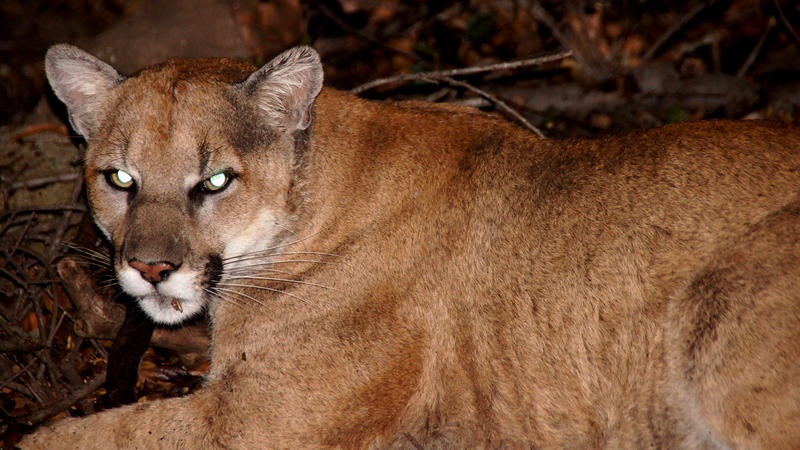
This National Park Service photograph shows P-22. The mountain lion is believed to have come from the Santa Monica Mountains, which would mean he crossed both the 405 and the 101 freeways to get to Griffith Park.
Gullies and thickets conceal his circuit, a routine no different than any other male lion’s: sleeping by day and, by night, hunting, warding off rivals, looking for a mate.
Days earlier, he wandered along the western border. The lights of Universal City and Warner Brothers reflected in his eyes.
Dropping into Coyote Canyon, he skirted Hollywood Knolls, its homes looking out toward the eastern sweep of the Valley. He heard dogs barking and cars and motorcycles accelerating on Barham Boulevard and the 101.
Later he wandered among the dead at Forest Lawn Memorial Park, a celebrity among celebrities. Deer and other prey are drawn to the flowers left in the cemetery and to the willows and sycamores covering Sennett Creek, and the lion has killed there before.
That night, though, he crossed through Mount Sinai Memorial Park and out toward Oak Canyon. With his long hind legs and powerful haunches, he can leap as high as 15 feet and as far as 40 feet, so few fences or walls are an impediment.
In the morning, he settled himself in the brush, not far from the terraces and plantings of Amir Dialameh, the Iranian emigre who restored this fire-ravaged portion of the park.
How P-22 got into Griffith Park is anyone’s guess. Researchers believe he was born in the Santa Monica Mountains. His father was P-1, and by the age of 2, he had a choice: Stay and fight for this territory or find new ground for himself.
Some have him bounding across the 405, but he might have found a tunnel and sidestepped the freeway construction after Carmageddon in 2011. Then came the walled estates, the canyon parks and Mulholland Highway before he discovered the Lakeridge or possibly the Pilgrimage bridge across the Hollywood Freeway.
Once in the park, he found enough deer and smaller prey to sustain him.
He has tried to catch the attention of female mountain lions with scratchings in the dirt, raked piles of leaves marked by urine, feces, secretions, and with an occasional purr and chirp. But there has only been silence in return, not the coupling that researchers describe almost lyrically, when a male and female lion’s GPS coordinates nearly merge and stay together for a week or so.
Biologists are surprised that P-22 has remained as long as he has in Griffith Park and have concluded that the cat recognizes the risk of leaving. Still it is possible that one day his instinctual drive to mate will lead him out of the park.
The isolation and the wanderlust of Southern California’s mountain lions do not bode well for the species.
“Pumas in areas like the Santa Monicas, the Santa Anas and especially the postage stamp of Griffith Park, are betting against the house,” says UC Davis biologist Walter Boyce. “In the long run, the house always wins.”
Orion’s belt, three pricks of light not quite lost in the city’s luminous glow, clears the ridgeline to the east.
P-22 strikes. Flexor muscles extend inch-long claws into the soft tissue of a raccoon.
He bites into the back of the mammal’s neck, severing the spinal cord with a jaw strength that few other creatures can match.
With the limp body hanging from his mouth, he disappears into the brush, where he licks the fur off its skin, tears the flesh and gnashes through bone with his sharp teeth. He prefers the muscles, the heart, lungs, kidneys and liver — tissue and organs most rich in blood and fat — to the stomach and intestines.
He takes his time with the quarry, burying it and wandering off, then returning to eat.
By the time he is finished, there’s little left other than a mound of hair, a paw and the small Halloween mask of its face, remnants that Sikich and his colleague, Seth Riley, discover when they trace the lion’s route a week later.
While biologists marvel at P-22’s ability to adapt, they want to make it easier for other mountain lions. They hope that one day a wildlife bridge will span the 101 at Liberty Canyon, so that lions and other species can wander between the Santa Monica Mountains and the Simi Hills and the Santa Susana Mountains. The goal is to connect these smaller enclaves with the Los Padres National Forest where there is greater genetic diversity.
There is an urgency to this hope.
On the second day after P-22’s raccoon kill, a lion labeled P-39 tried to run north across the 118 Freeway near Chatsworth. A vehicle hit her. The impact knocked her collar off, and her body was recovered by Caltrans.
Within six weeks, two of her three blue-eyed cubs had also been struck down on that freeway.
At 01:00, Dec. 5, P-22’s collar switches on. He is south of Mt. Lee, heading toward Beachwood Drive.
To the west is the Hollywood sign, to the east the Observatory, and to the south, haze smudges the city streets and distant skyscrapers.
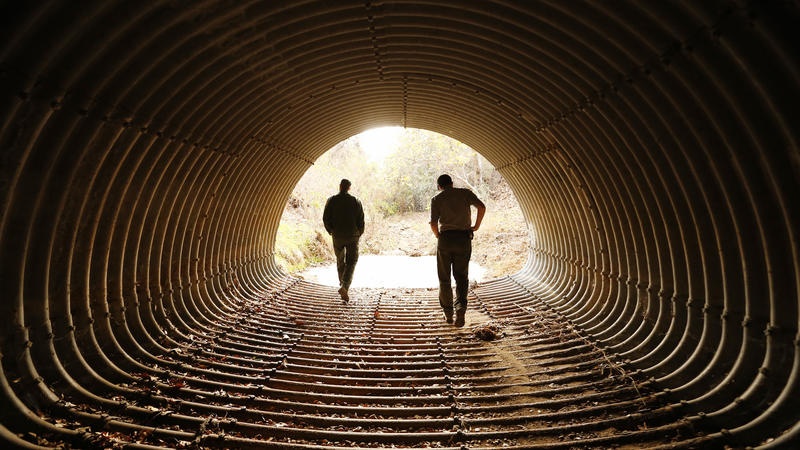
Wildlife ecologist Seth Riley, right, and Jeff Sikich, a biologist for the National Park Service, walk through a tunnel used by P-22 as the mountain lion makes his way around the north end of Griffith Park and neighboring properties. The pair use maps and data from a radio collar worn by P-22 to observe his travels.
He cuts southwest to Lake Hollywood and makes his way through a break in the 10-foot tall fence, reaching the secluded watershed. Pines, deodars, toyon and laurel provide cover as he waits for deer to wander close.
He’s completed a seven-day circumnavigation of the park.
Ingenuity in the name of survival isn’t unique to P-22, but he is the luckiest.
Since 2002 when National Park Service biologists started studying mountain lions in Southern California, eight have been killed by other mountain lions, six have been killed by cars or trucks, three have died of anticoagulant poisoning and three cubs have died of starvation and abandonment.
One cat, P-15, was found with his head and paws cut off. A promised reward never flushed out the hunters.
As for P-22, he is getting old, almost 7. Mountain lions seldom live longer than 10 years in the wild. His collar has a mortality sensor that alerts Sikich and Riley if he has not moved in 12 hours.
So far, the absence of that signal reassures them that the city still has room for the big cat to roam.

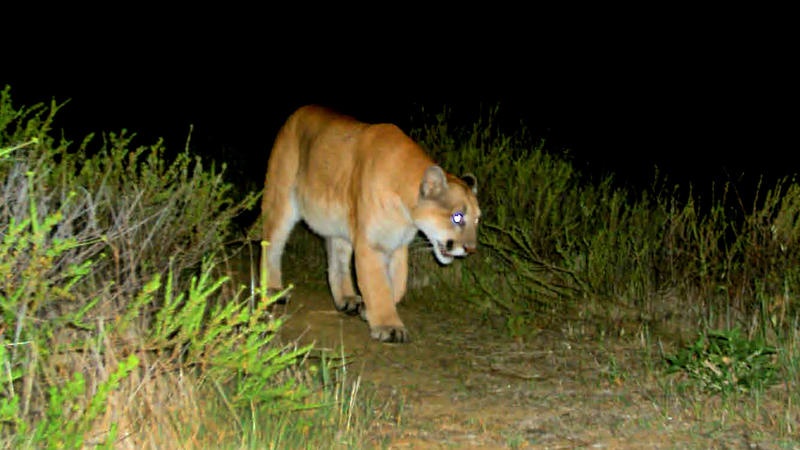
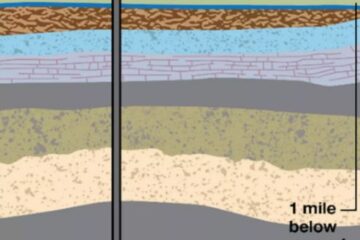
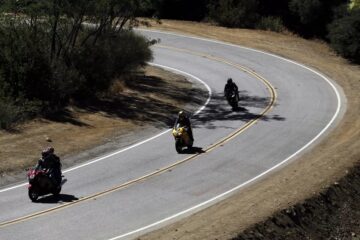
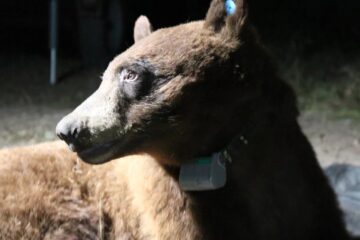
0 Comments